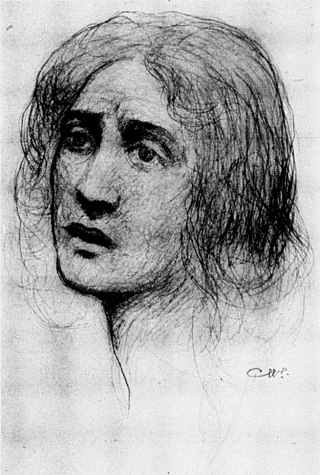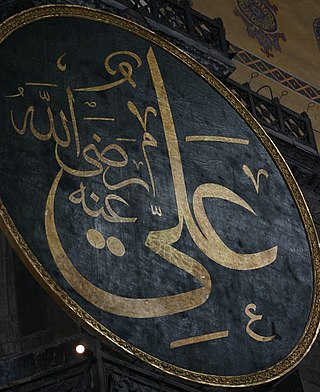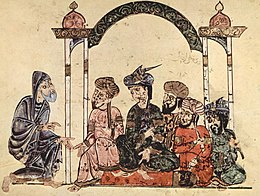
Tumāḍir bint ʿAmr ibn al-Ḥārith ibn al-Sharīd al-Sulamīyah, usually simply referred to as al-Khansāʾ was a 7th-century tribeswoman, living in the Arabian Peninsula. She was one of the most influential poets of the pre-Islamic and early Islamic periods.

Fāṭima bint Ḥuzām, better known as ʾUmm al-Banīn, was a wife of Ali ibn Abi Talib, the fourth Rashidun caliph and the first Shia Imam. She belonged to the Banu Kilab, a tribe within the Qays confederation. Umm al-Banin married Ali sometime after the death in 632 CE of his first wife Fatima, daughter of the Islamic prophet Muhammad. She bore Ali four sons who were all killed in the Battle of Karbala.
Layla bint Abullah ibn Shaddad ibn Ka’b al-Akhyaliyyah, or simply Layla al-Akhyaliyyah was a famous Umayyad Arab poet who was renowned for her poetry, eloquence, strong personality, and beauty. Nearly fifty of her short poems survive. They include elegies for her lover Tawba ibn Humayyir, lewd satires she exchanged with al-Nabigha, and panegyrics for the caliphs Uthman and Abd al-Malik ibn Marwan;
Mariam bint Abu Ya'qub Ashshilbi was an 8th-century Arabic-language poet of al-Andalus. She was born in Shilb and settled in Seville, where she became a tutor of noblewomen.
Ḥafṣa bint al-Ḥājj ar-Rakūniyya was a Granadan aristocrat and perhaps one of the most celebrated Andalusian female poets of medieval Arabic literature.
Nazhūn bint al-Qulāʽiya al-Gharnātiya was a Granadan Qiyan and poet, noted for her outrageous verse.
Ḥamda bint Ziyād al-Muʾaddib was a twelfth-century Andalusian poet from Guadix, sister of Zaynab bint Ziyad al-Muʾaddib, and described by the seventeenth-century diplomat Mohammed ibn abd al-Wahab al-Ghassani as 'one of the poetesses of the Andalus. She is famous in that region and among all the poets and poetesses of the country.' Her father was a teacher (mu'addib), and she is described as being one of 'the brotherless only daughters of well-off and cultured fathers who gave them the education that they would have given to their male children, if they had had any'. She is one of relatively few named Moorish women poets.
ʿArīb al-Ma’mūnīya was a qayna of the early Abbasid period, who has been characterised as 'the most famous slave singer to have ever resided at the Baghdad court'. She lived to the age of 96, and her career spanned the courts of five caliphs.
Ulayya bint al-Mahdi was an Abbasid princess, noted for her legacy as a poet and musician.
Hind bint al-Nuʿmān, also known as al-Ḥurqah, was a pre-Islamic Arab poet. There is some historiographical debate, going back to the Middle Ages, over precisely what her names were, with corresponding debates over whether some of the bearers of these names were different people or not. An example of a poet-princess, she has been read as a key figure in pre-Islamic poetry.
Laylā bint Ṭarīf was a female warrior and poet and one of the Khawarij, a group known for its members' fanaticism and violent opposition to the established Caliphate, believing that leadership of the Muslim community was not limited to male Arabs of the Quraysh tribe. On the basis of women fighting alongside Muhammad, the Khawarij have viewed combat as a requirement for women, and Laylā bint Ṭarīf is a prominent example of this custom. Laylā was the sister of the Kharijite leader al-Walid ibn Tarif al-Shaybani. After al-Walīd's death, Laylā took on the leadership of his army and fought two battles before her clan forced her to step down.
Umm ‘Alī Taqiyya bint Abi’l-Faraj Ghayth b. ‘Alī b. ‘Abd al-Salām b. Muḥammad b. Ja‘far al-Sulamī al-Armanāzī al-Ṣūrī, also known as Sitt al-Ni‘m, was a poet and scholar, the most prominent female student of Abū Ṭāhir al-Silafī, the leading educator in Egypt in his day.
Maysun bint Bahdal was a wife of caliph Mu'awiya I, and as mother of his successor and son Yazid I. She belonged to a ruling clan of the Banu Kalb, a tribe which dominated the Syrian steppe. Mu'awiya's marriage to her sealed his alliance with the tribe.
ʽInān bint ʽAbdallāh was a prominent poet and qiyan of the Abbasid period, even characterised by the tenth-century historian Abū al-Faraj al-Iṣfahāni as the slave-woman poet of foremost significance in the Arabic tradition. She was later the concubine of Harun al-Rashid.
Afira bint 'Abbad was an Arab poet from around the 3rd century CE, from what is now Bahrain.
Laila bint Lukaiz or Layla bint Lukayz, otherwise known as "Layla the Chaste", was a legendary Arab poet and one of the leading poets of the fifth century.

Qiyān were a social class of women, trained as entertainers, which existed in the pre-modern Islamic world. The term has been used for women who were both free, including some of whom came from nobility, and non-free women. It has been suggested that "the geisha of Japan are perhaps the most comparable form of socially institutionalized female companionship and entertainment for male patrons, although, of course, the differences are also myriad".
Umm Assa'd bint Isam al-Himyari was a Muslim Arabic poet.
The literature of al-Andalus, also known as Andalusi literature, was produced in al-Andalus, or Islamic Iberia, from the Muslim conquest in 711 to either the Catholic conquest of Granada in 1492 or the expulsion of the Moors ending in 1614. Andalusi literature was written primarily in Arabic, but also in Hebrew, Latin, and Romance.
Lubāna bint ʿAlī ibn al-Mahdī was an Abbasid princess, Arabic poet and the principal wife of caliph al-Amin. She was the daughter of Ali, a son of the third Abbasid caliph, al-Mahdi.



